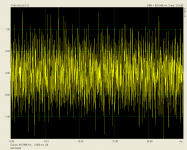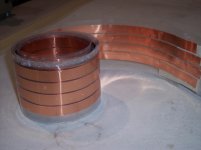http://www.diyaudio.com/forums/loun...ch-preamplifier-part-ii-5147.html#post3909111I am not sure what you mean
Wouldn't a silicon cap be essentially the same as a glass cap? http://www.avx.com/docs/Catalogs/gl-cyintro.pdf The dielectric is the same material to start with I believe.
Aren't silicon capacitors two layer dielectrics?
@DavidL,
Thats just silly , Mi suspect you need to work on your comprehension....
I'll write this down then
I also have test equipment, how about you?
Yep that $8000 plus SR1 sure came in handy testing those tantalum caps. How else would we have known that tantalums are so bad?
He has had a new SYS-2722, for about 6 or more years.
Yeah I guess THAT one can't test cables, power cords or magic bowls either
For magazine reviews, I would suggest to place the amplifier under test behind the curtain and never tell the reviewer what is tested. Then, he should write a review based on listening only, without having an idea what amplifier it was. One assistant might help to operate the amp and associated equipment.
Will NEVER happen at Stereophile. Both Atkinson and Serinus have partaken in DBT and they both got burned in not being able to tell differences between amps and power cords then came up with the usual excuses and then denied that DBT is a reliable way to test audio equipment. Gotta keep the wool pulled over the magazine's reader's eye ya know.
Wouldn't a silicon cap be essentially the same as a glass cap? http://www.avx.com/docs/Catalogs/gl-cyintro.pdf The dielectric is the same material to start with I believe. IC processing allows much smaller and denser parts.
http://www.mouser.com/pdfDocs/IPDiA_HiTEmp Abstract.pdf
Found this when looking into them, Sy was correct.
Very high prop speed, very low inductance caused by the long reluctance path. Forgot the characteristic Z though. Made a clone years ago using half inch wide copper ribbon. The only significant difference is their construction has less eddy loss at very high frequencies because they use lots if independent conductors to break lateral conduction. However, proximity effect still occurs on theirs, but just on a conductor by conductor loop exclusion.JN, thoughts on this 4 conductor version ...?
Given the high prop speed, it will suffer less timing changes as a consequence of load impedance variations. How much, I don't have any numbers, nor can I say it's audible or not.
I don't trust the test.
When it comes to IC's or PC's, I also do not trust a switchbox.
Ownership is only one aspect. Understanding it well is another. Being able to design test setups which suffer no confounders is a third. The ability to determine the impact uncorrected confounders have is a fourth. And last, baselining the equipment and test setup to understand the limits is fifth.I also have test equipment, how about you?
The last test I recall you posting years ago had 1 and 2. You did not show any semblance of control over 3 through 5, and ignored all dialogue explaining why they were important.
jn
That's valid for a speaker in a space. It tests for reverberation and distortions that would obscure the details in speech.
I don't think it would yield much in decent electronics. We need to look elsewhere.
If you can take all 45min., demonstration of generation loss
Alvin Lucier - I Am Sitting In A Room - YouTube
The reason that I put out my extra income to invest in new test equipment, was to lower the residual, and establish a new baseline. I always baseline my equipment to the best of what the equipment is capable of.
The problem with an all digital instrument, rather than a combination of analog and digital, is the moving baseline depending on the test frequency used, for example. Analog was actually more predictable.
The problem with an all digital instrument, rather than a combination of analog and digital, is the moving baseline depending on the test frequency used, for example. Analog was actually more predictable.
The reason that I put out my extra income to invest in new test equipment, was to lower the residual, and establish a new baseline. I always baseline my equipment to the best of what the equipment is capable of.
The problem with an all digital instrument, rather than a combination of analog and digital, is the moving baseline depending on the test frequency used, for example. Analog was actually more predictable.
It's not the equipment you didn't baseline, it was the test setup.
You tend to neglect that. And that is where I have good experience, which I've offered over the years.
jn
Very high prop speed, very low inductance caused by the long reluctance path. Forgot the characteristic Z though. Made a clone years ago using half inch wide copper ribbon. The only significant difference is their construction has less eddy loss at very high frequencies because they use lots if independent conductors to break lateral conduction. However, proximity effect still occurs on theirs, but just on a conductor by conductor loop exclusion.
Given the high prop speed, it will suffer less timing changes as a consequence of load impedance variations. How much, I don't have any numbers, nor can I say it's audible or not.
When it comes to IC's or PC's, I also do not trust a switchbox.
jn
Tks
No prob. Found this pic on my other computer, but can't find the excel sheet with the test data for it. L, and C vs Freq out to 100K..I'll keep on trying.
jn
Attachments
Personally, JN, I don't trust your 'experience'. You appear to find 'fault' with every exotic test that comes around. I have not seen anything useful from you, (to me) however.
It is my opinion that your 'offer' is to make you look more important on this thread than actually wanting to help me. Besides, you don't make these sorts of measurements in any case. If I need help, I will contact Stanford Research, or my associates who are better educated than you or me put together.
It is my opinion that your 'offer' is to make you look more important on this thread than actually wanting to help me. Besides, you don't make these sorts of measurements in any case. If I need help, I will contact Stanford Research, or my associates who are better educated than you or me put together.
You appear to find 'fault' with every exotic test that comes around.
With badly designed and poorly controlled tests, yes. And rightly so. But following jn's advice may not be useful to your ultimate goal of moving boxes by waving around impressive-looking charts to people who aren't experts as a post hoc justification of your fashion choices. jn's advice is, however, extremely useful in obtaining valid measurements, which clearly isn't your goal.
- Status
- Not open for further replies.
- Home
- Member Areas
- The Lounge
- John Curl's Blowtorch preamplifier part II

